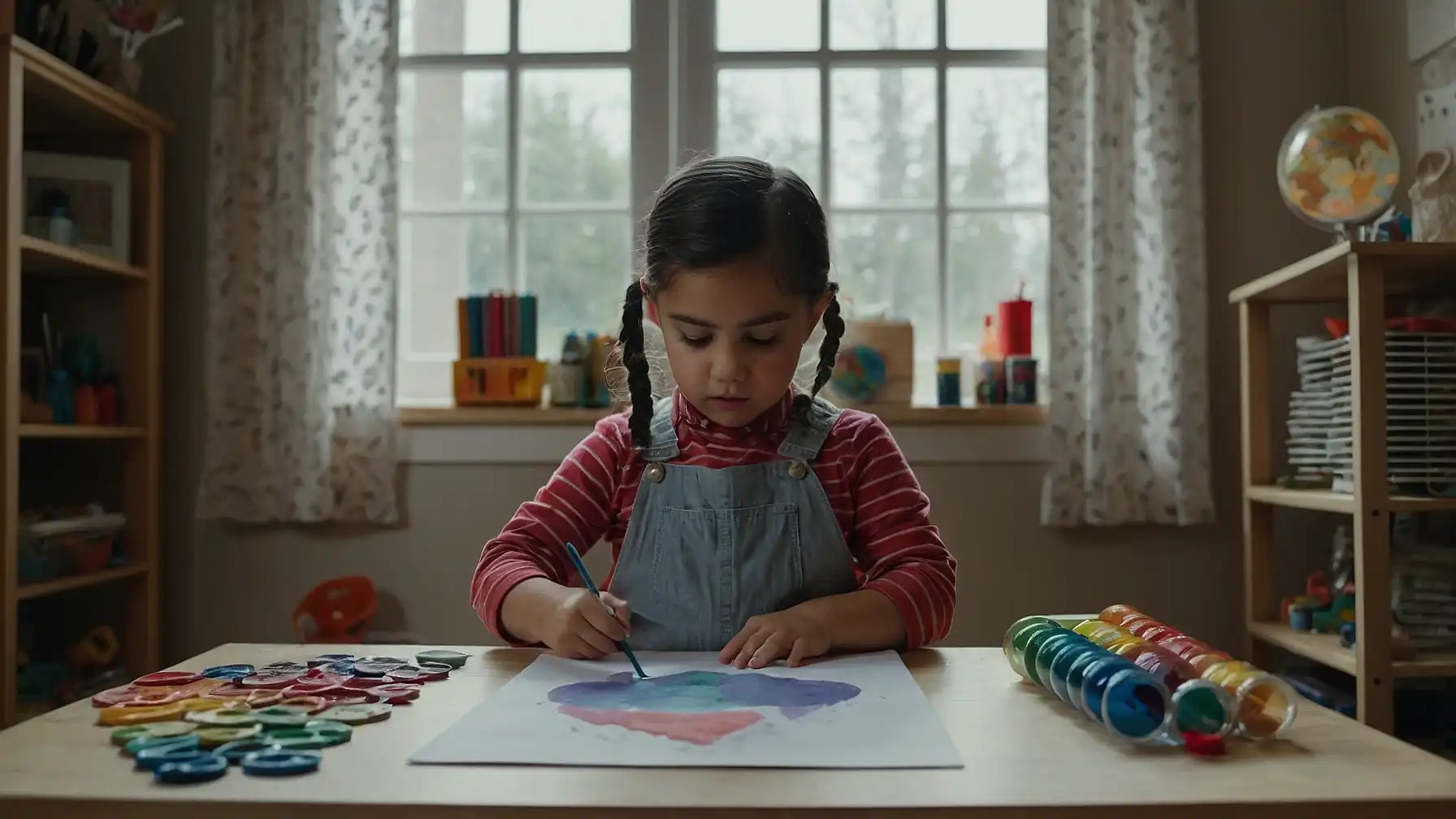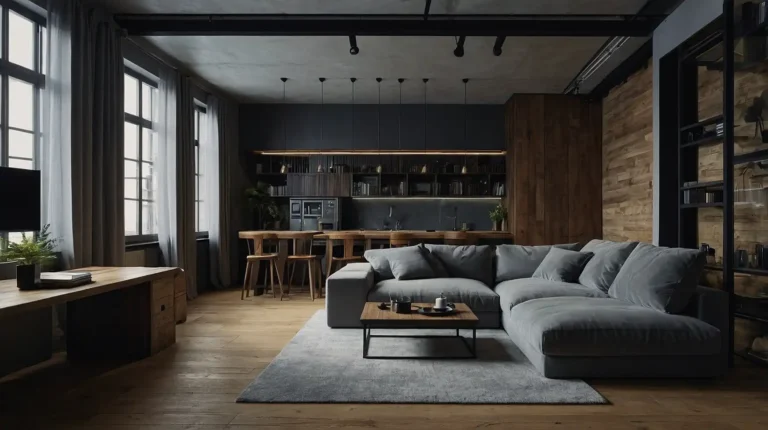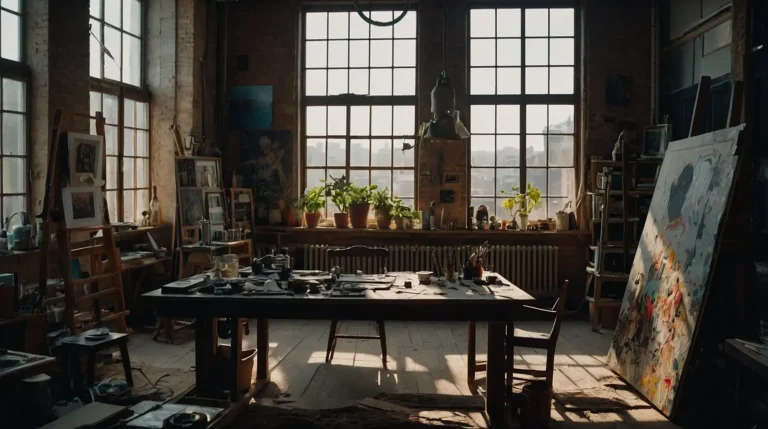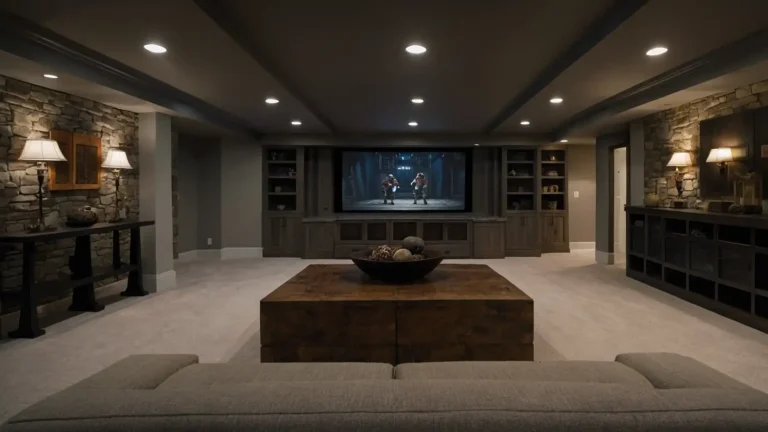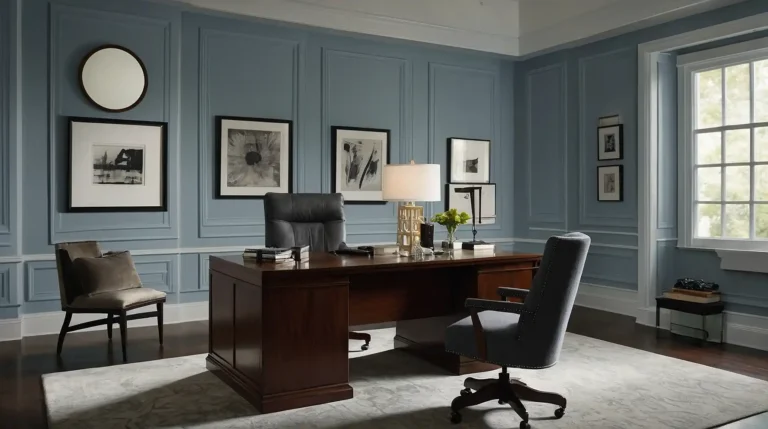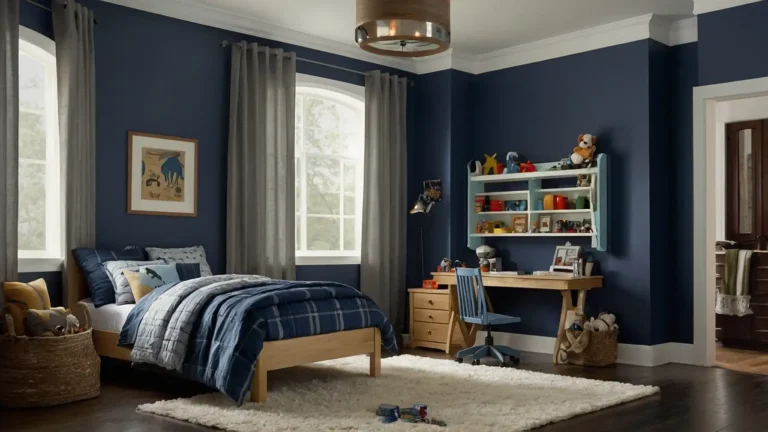27 Montessori Art Studio Tips
Creating a Montessori art studio transforms your child’s creative experience by emphasizing independence, beauty, and natural materials.
This approach honors children’s innate artistic abilities while building confidence through carefully prepared environments.
Montessori art principles focus on process over product, allowing children to explore materials freely while developing fine motor skills and creative expression.
You’ll discover how to set up spaces that invite exploration and support natural learning.
These tips will help you create an art studio that nurtures creativity, independence, and joy in artistic discovery.
1: Use Child-Height Storage
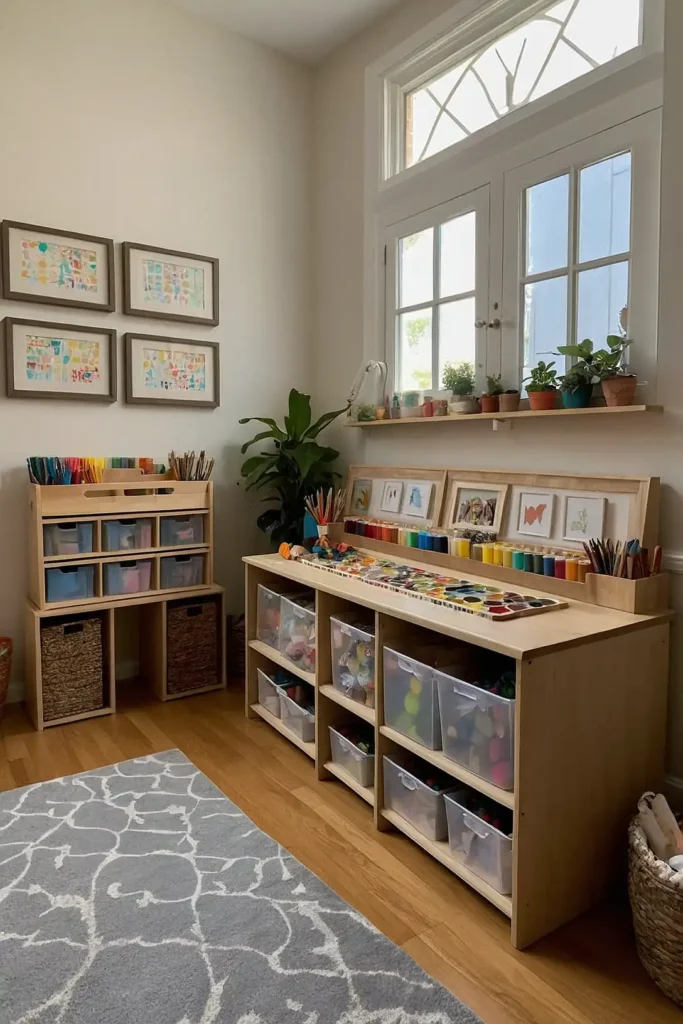
Position all art supplies on low, accessible shelves where children can independently choose and return materials.
This autonomy builds confidence while teaching responsibility for their creative environment.
Install shelving at 24-30 inches high for easy reach. Label shelves with pictures and words for literacy development.
Children develop decision-making skills when they control their material choices without adult assistance.
This organization system supports independence while maintaining the order essential to Montessori environments.
2: Provide Real Art Tools
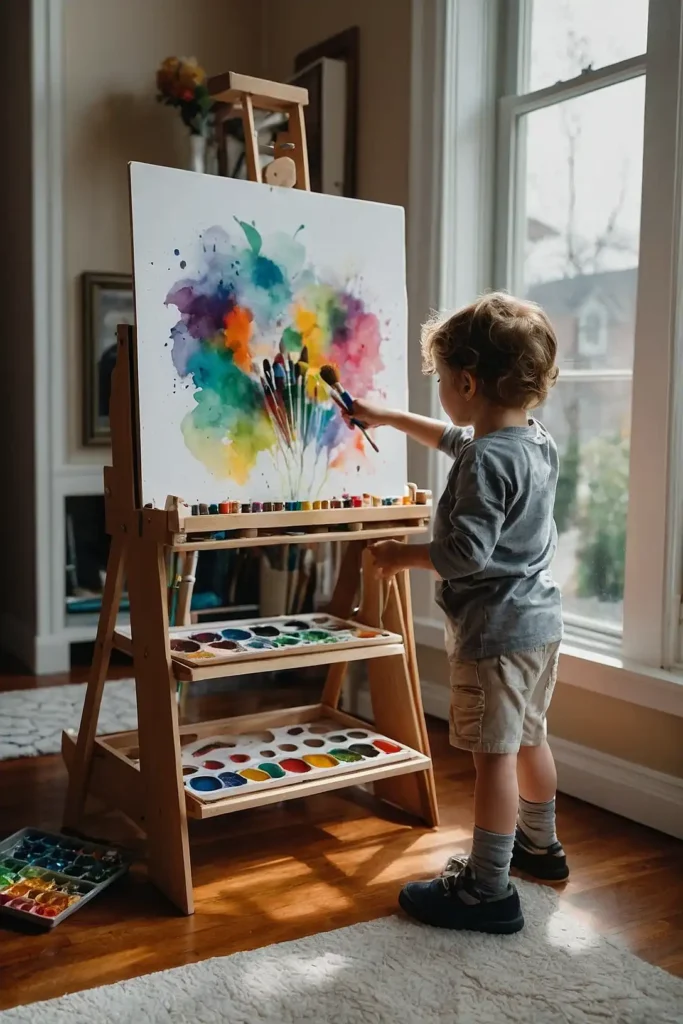
Offer authentic brushes, quality paper, and real scissors rather than toy versions that frustrate children and limit their artistic potential.
Respect for children includes trusting them with proper tools. Choose tools sized appropriately for small hands but made with quality materials.
Children sense the difference between real and fake, responding more seriously to authentic equipment.
Teach proper care and handling of quality tools. This responsibility builds self-esteem while developing practical life skills through meaningful art activities.
3: Emphasize Process Over Product
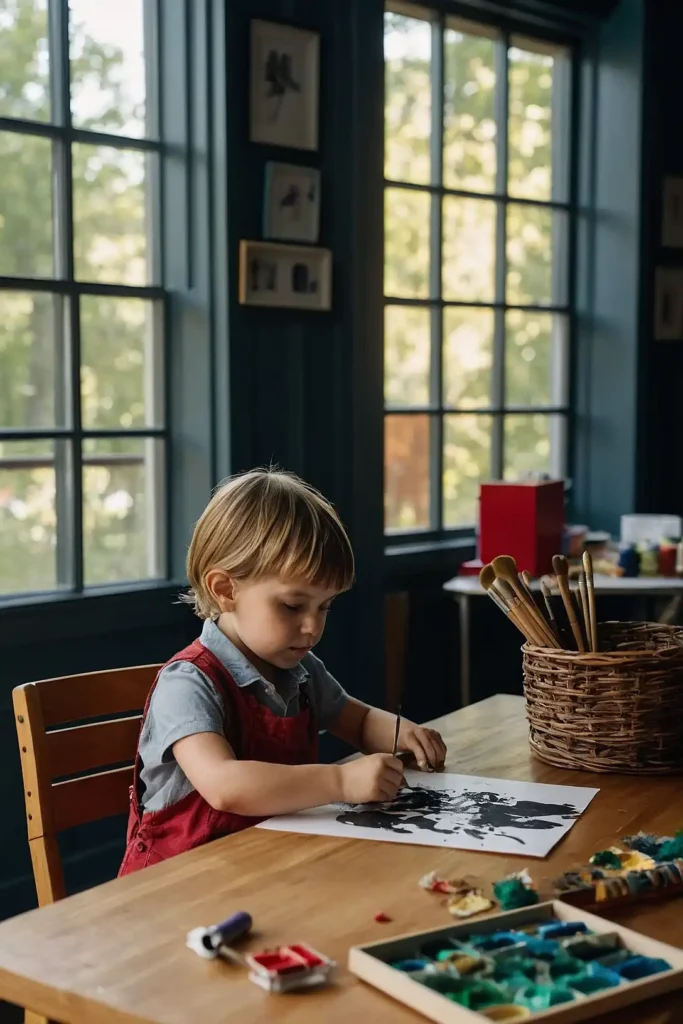
Create environments where children explore materials without pressure to produce specific outcomes.
This freedom allows natural creativity to flourish while building intrinsic motivation for artistic expression.
Avoid displaying only “perfect” artwork that makes children feel inadequate. Instead, celebrate effort, exploration, and the joy children find in creative processes.
Document children’s creative journey through photos rather than just final products.
This approach honors their learning process while building confidence in artistic abilities.
4: Organize Materials in Beautiful Baskets
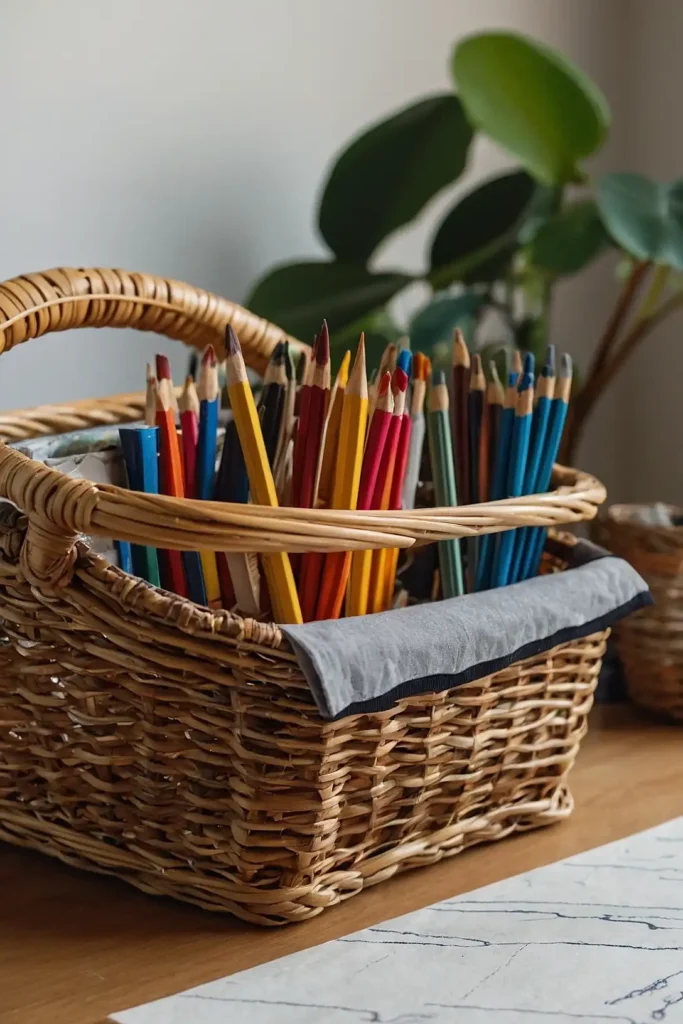
Present art supplies in natural wicker baskets or wooden containers that invite children to explore materials.
Beautiful presentation conveys respect for both children and their creative work. Choose containers that children can easily carry and clean.
Group related materials together in individual baskets for easy transport to work areas.
This organization supports independence while maintaining order in the studio space.
The practical aspects teach responsibility while the beauty inspires reverence for artistic materials.
5: Create Defined Work Spaces
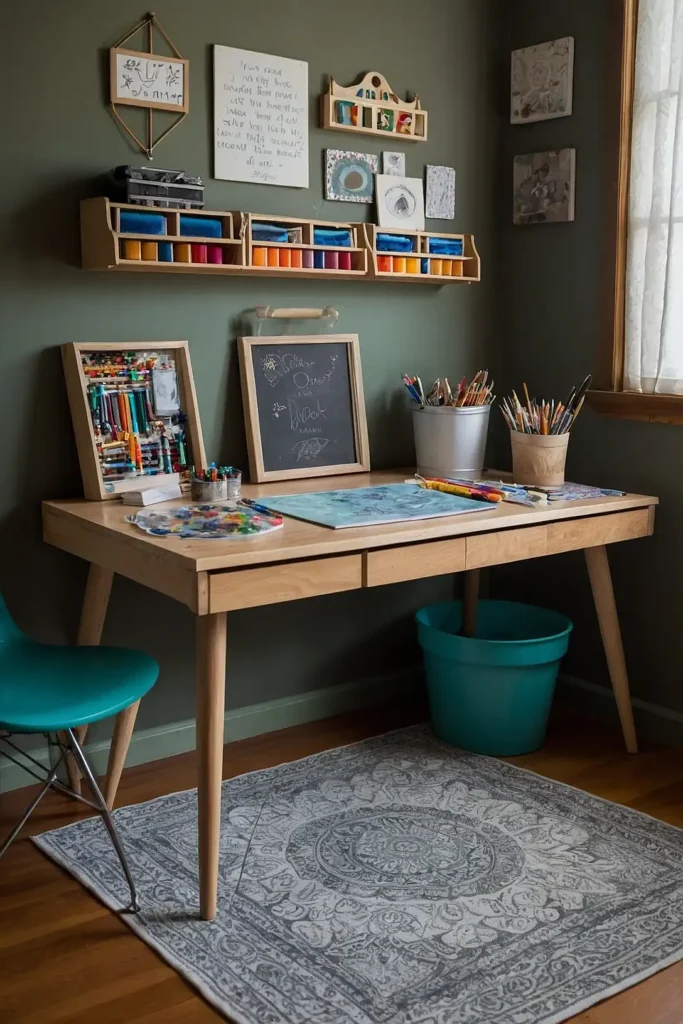
Establish clear areas for different artistic activities using low tables, floor mats, or designated stations.
This structure helps children focus while providing freedom to choose their workspace.
Include both individual and collaborative spaces for different types of artistic expression.
Children need options for solitary creation and social artistic experiences. Ensure each space has adequate lighting and ventilation for comfort.
The physical environment directly impacts children’s ability to concentrate and create meaningful work.
6: Offer Natural Art Materials
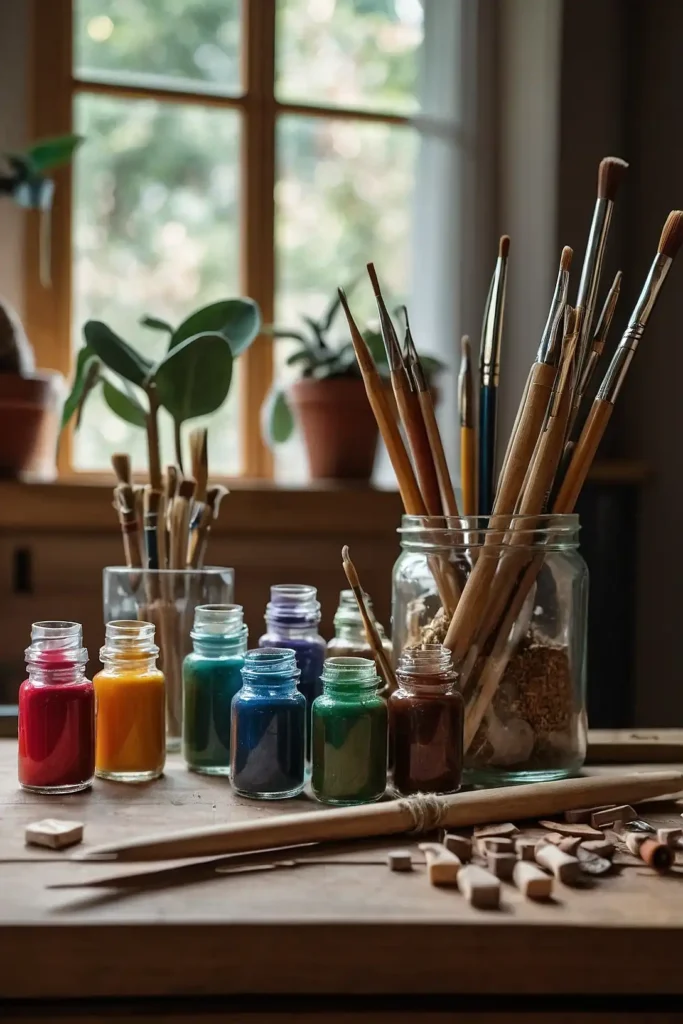
Incorporate shells, stones, leaves, and wood pieces alongside traditional supplies for rich sensory experiences that connect children to nature through their artistic expressions.
Natural materials provide varying textures, weights, and visual appeal that manufactured supplies cannot match.
Children develop deeper sensory awareness through these authentic experiences. This approach teaches observation skills while providing fresh creative inspiration.
Change natural materials seasonally to maintain interest and connection to environmental cycles.
7: Maintain Minimal Color Palettes
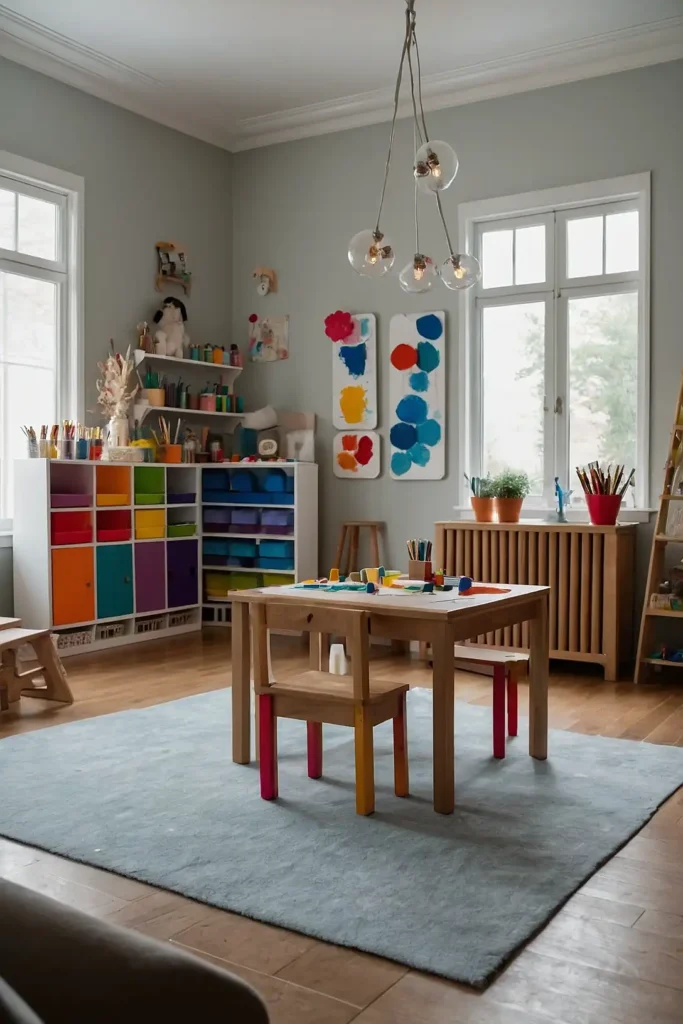
Present fewer color choices to prevent overwhelm while encouraging deeper exploration of color mixing and relationships.
Quality over quantity applies to color selection in Montessori environments. This sequential approach builds understanding systematically.
Start with primary colors and gradually introduce secondary options as children master basic mixing techniques.
Use natural pigments when possible for authentic color experiences.
Children appreciate the difference between artificial and natural colors, developing aesthetic sensitivity through quality materials.
8: Include Practical Life Elements
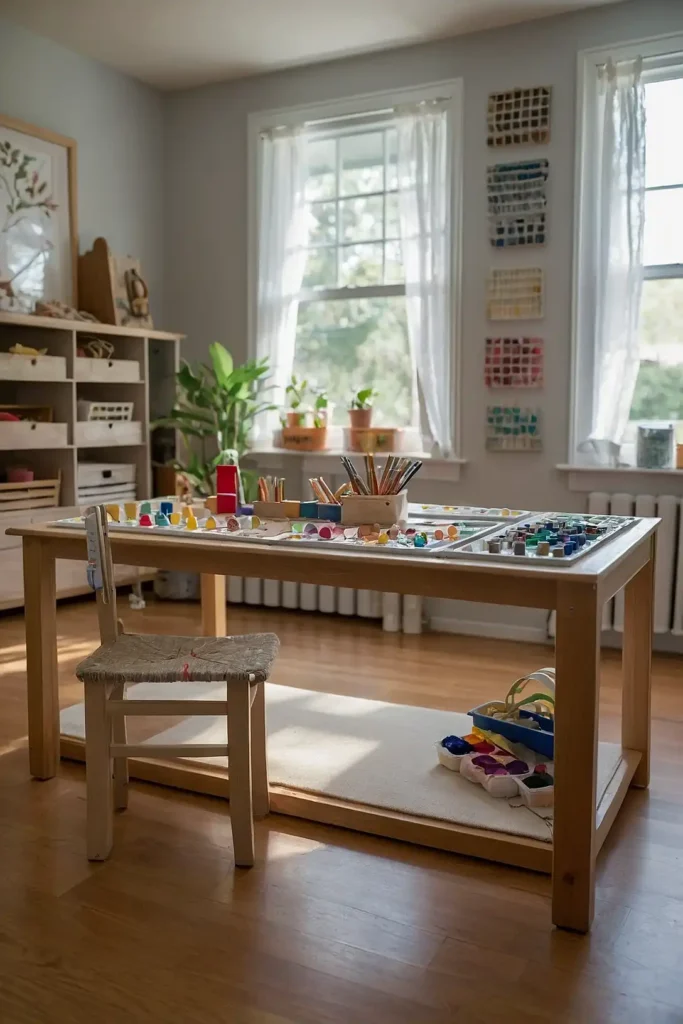
Integrate cleaning supplies, aprons, and wash stations so children can maintain their workspace independently.
This responsibility builds self-confidence while teaching life skills through artistic activities.
Provide child-sized brooms, cloths, and water containers for easy cleanup. Children take pride in maintaining their environment when given appropriate tools.
Teach specific cleaning sequences that children can follow independently. This practical life integration supports the Montessori principle of caring for one’s environment.
9: Display Art at Child Eye Level
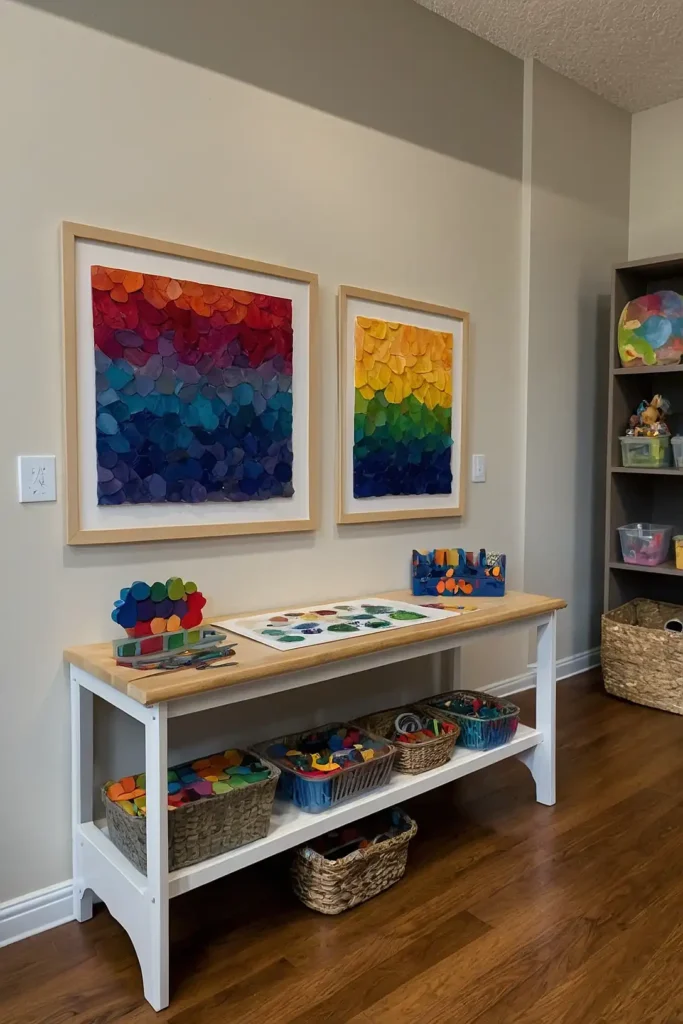
Hang children’s artwork and inspiring examples at their viewing height rather than adult height. This respect for their perspective encourages appreciation for artistic beauty.
Include diverse artistic styles and cultural examples to broaden children’s aesthetic awareness. Exposure to various art forms develops appreciation for different expressions.
Rotate displays regularly to maintain interest and showcase different children’s work. This practice ensures all children see their efforts valued and celebrated equally.
10: Provide Uninterrupted Work Time
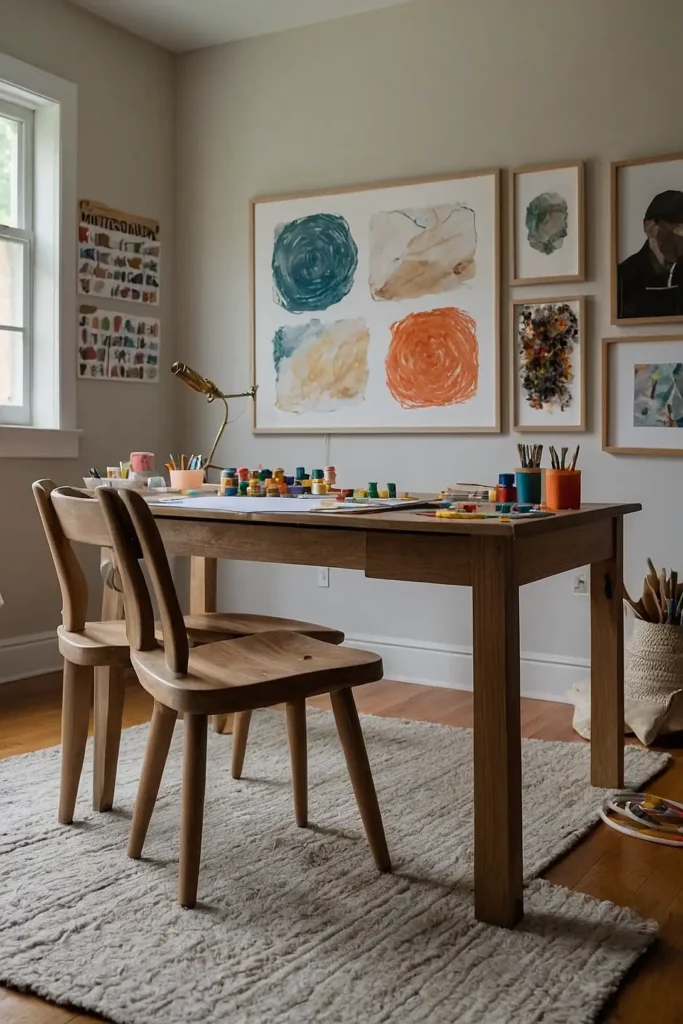
Allow children extended periods for artistic exploration without rushing them to finish or clean up.
Deep concentration develops when children have sufficient time for meaningful work.
Observe when children enter flow states and protect these precious moments of focused creativity.
Interruptions break concentration and diminish the quality of artistic experience.
Schedule art time when children are fresh rather than tired. Quality creative work requires mental energy that decreases throughout the day.
11: Use Trays for Material Organization
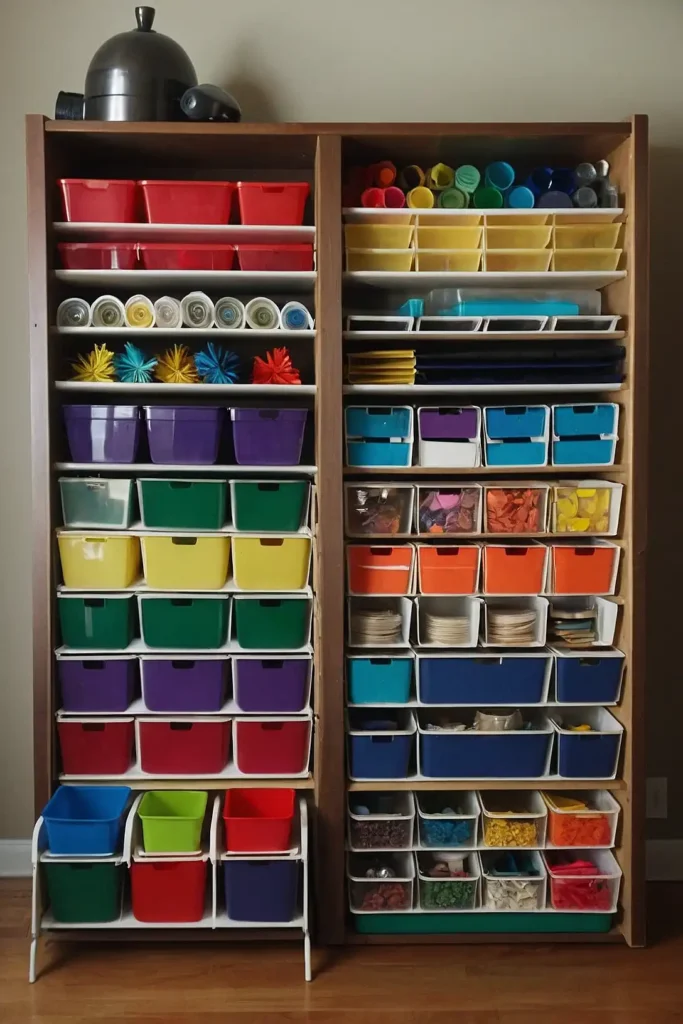
Present complete art activities on individual trays that children can carry to their chosen workspace.
This system promotes independence while maintaining organization throughout the studio.
Include all necessary materials on each tray to prevent interruptions during creative work.
Children maintain focus when everything they need is readily available. This practical skill development supports physical coordination and responsibility.
Choose trays that children can manage easily while learning to balance and transport materials carefully.
12: Create a Print-Making Station
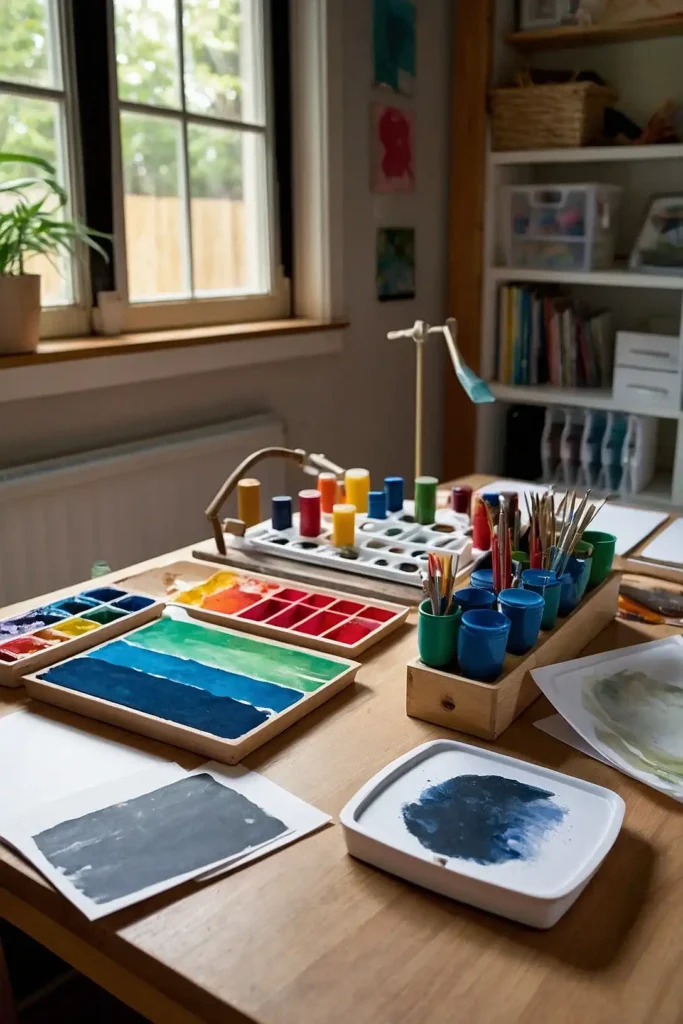
Set up a dedicated area for simple printmaking using stamps, rollers, and ink pads.
This specialized station introduces children to artistic techniques while building fine motor skills.
Include natural materials like leaves and vegetables for creating unique prints. Provide step-by-step visual guides for different printmaking techniques.
Children discover pattern-making while connecting artistic expression to natural forms and textures.
These supports enable independent exploration while building understanding of artistic processes systematically.
13: Offer Mixed-Age Artistic Experiences
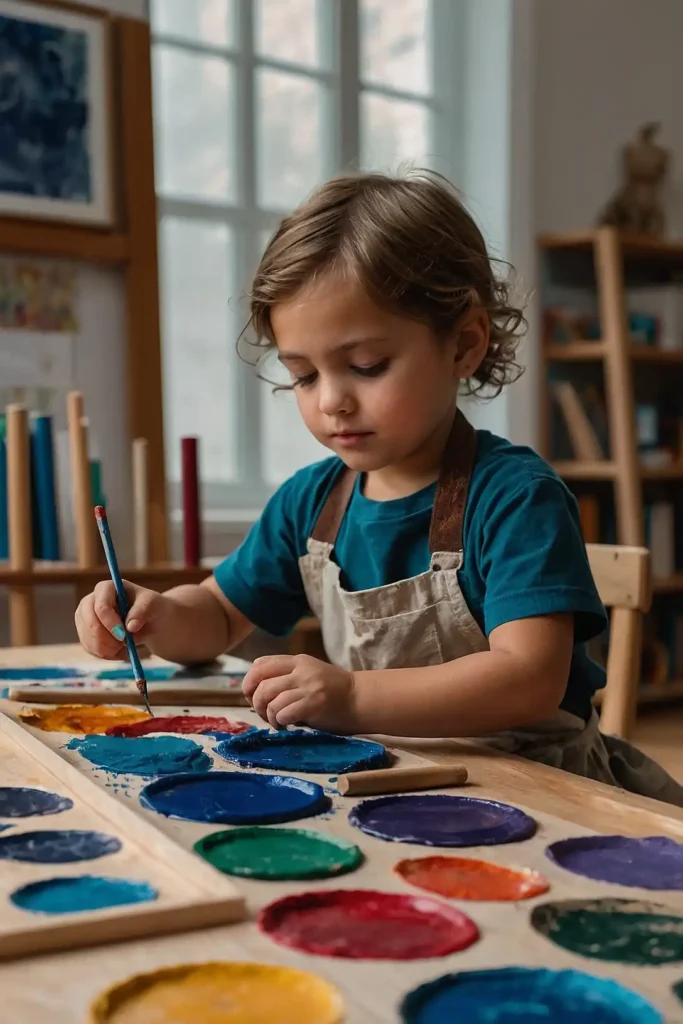
Encourage older children to mentor younger ones in artistic techniques, building community while reinforcing learning through teaching.
This collaboration reflects natural learning patterns. Both age groups benefit from these natural mentoring relationships.
Younger children observe advanced techniques while older children solidify their understanding by explaining processes.
Plan collaborative projects that require different skill levels for completion.
These experiences teach cooperation while celebrating each child’s unique contributions to shared artistic goals.
14: Include a Nature Sketching Area
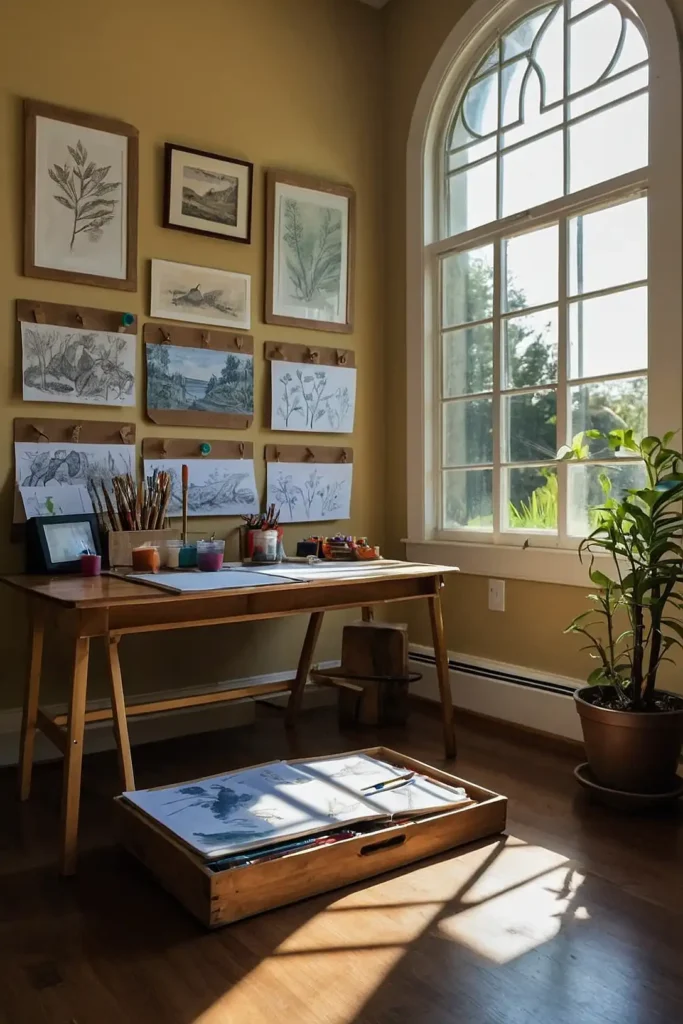
Designate space near windows or outdoors for observational drawing of natural subjects.
This connection to nature develops observation skills while inspiring artistic expression.
Provide magnifying glasses and field guides to enhance nature study through artistic documentation.
Children develop scientific observation skills through detailed artistic recording.
Change natural specimens seasonally to maintain interest and connection to environmental cycles.
This approach teaches patience and sustained observation through artistic practice.
15: Use Neutral Background Colors
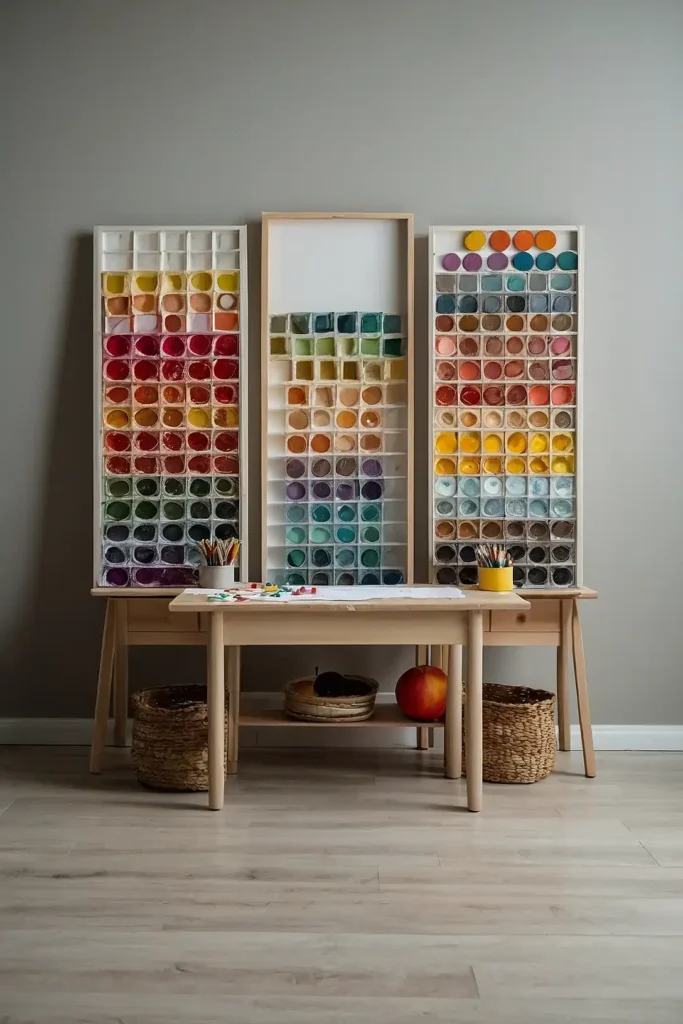
Paint walls in soft, neutral tones that don’t compete with children’s artwork or distract from their creative focus.
The environment should support rather than overwhelm artistic expression.
Choose colors that enhance natural light while creating calm, focused atmospheres.
Children concentrate better in environments that promote rather than stimulate their nervous systems.
Avoid busy patterns or bright decorations that distract from artistic work. The space itself should model the beauty and order children learn to create.
16: Provide Water Access
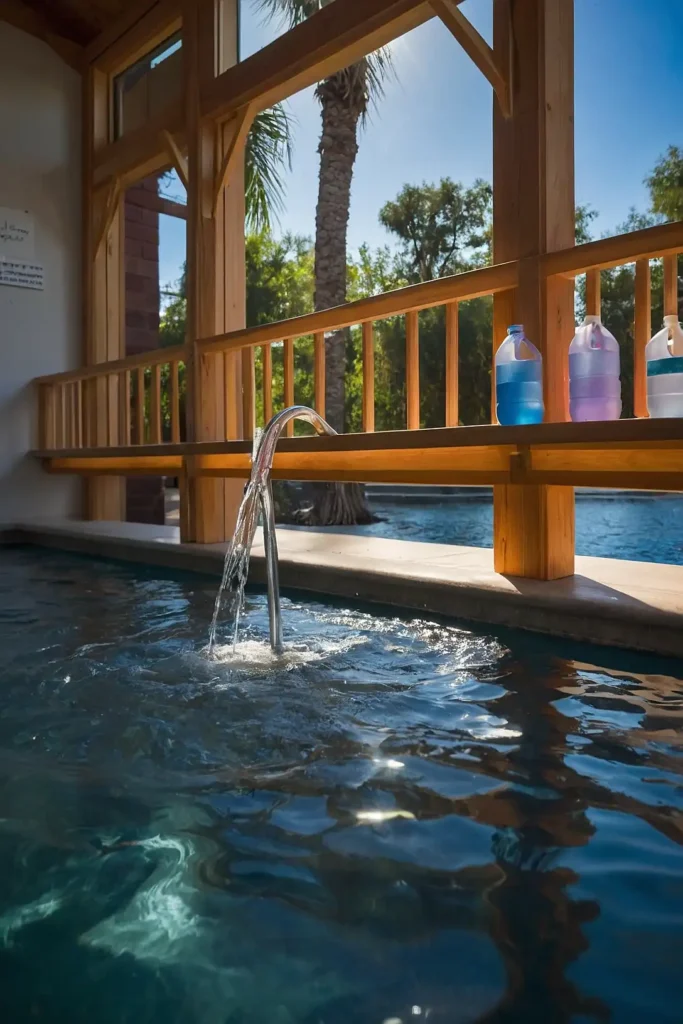
Install child-height sinks or water stations for independent brush cleaning and material preparation.
This practical access supports artistic independence while teaching responsible material care.
Include designated areas for wet and dry artwork to prevent mixing and damage.
Children learn material properties while developing organizational skills through artistic practice.
Teach proper water conservation and cleanup procedures as part of artistic responsibility.
These life skills integrate naturally with creative expression in prepared environments.
17: Introduce One Material at a Time
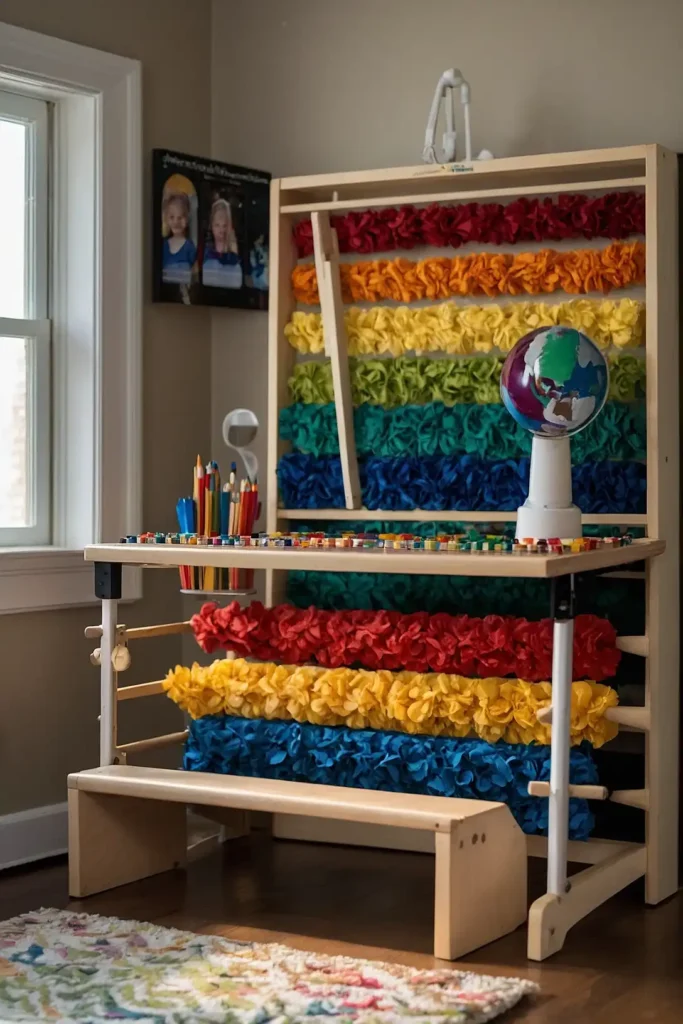
Present new art materials individually with proper demonstrations before combining them with other supplies.
This sequential introduction prevents overwhelm while building foundational skills. Allow thorough exploration of each material before adding complexity.
Children develop mastery and confidence when they fully understand individual components before combination work.
Document children’s progression with each material to inform future presentations.
This observation-based approach ensures appropriate challenge levels for continued engagement and growth.
18: Create Texture Exploration Opportunities
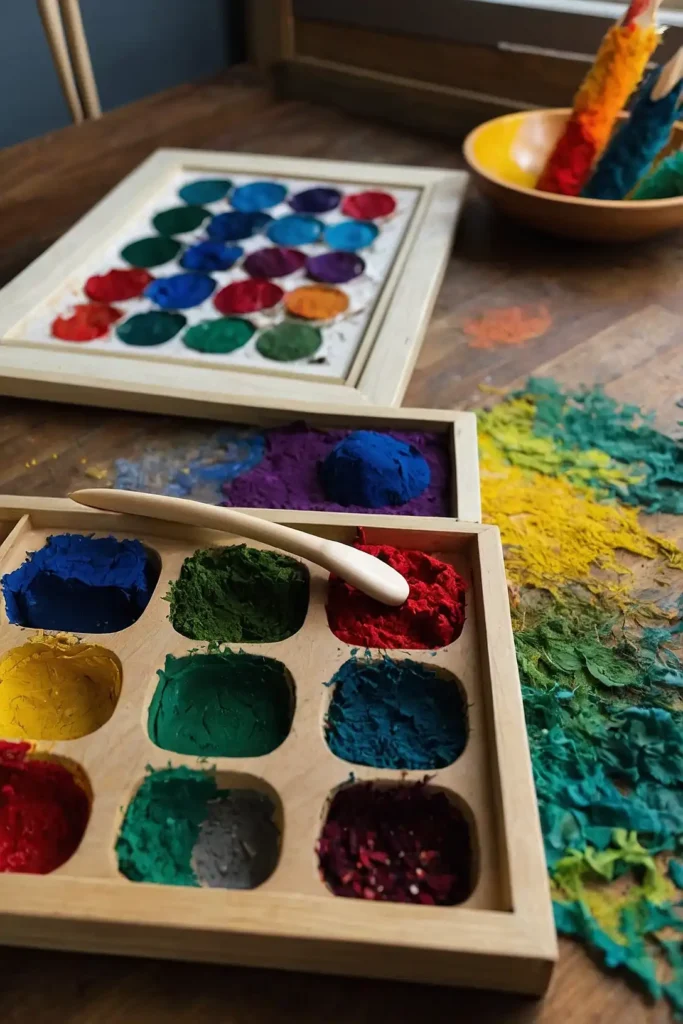
Provide materials with varying textures for tactile exploration through artistic creation.
This sensory experience develops aesthetic awareness while building neural connections through hands-on learning.
Include fabrics, papers, natural materials, and sculptural elements for diverse textural experiences.
Children develop vocabulary and sensitivity through rich sensory artistic exploration.
Encourage children to describe textural experiences verbally while creating.
This language development enhances both artistic and communication skills through integrated learning experiences.
19: Establish Quiet Work Zones
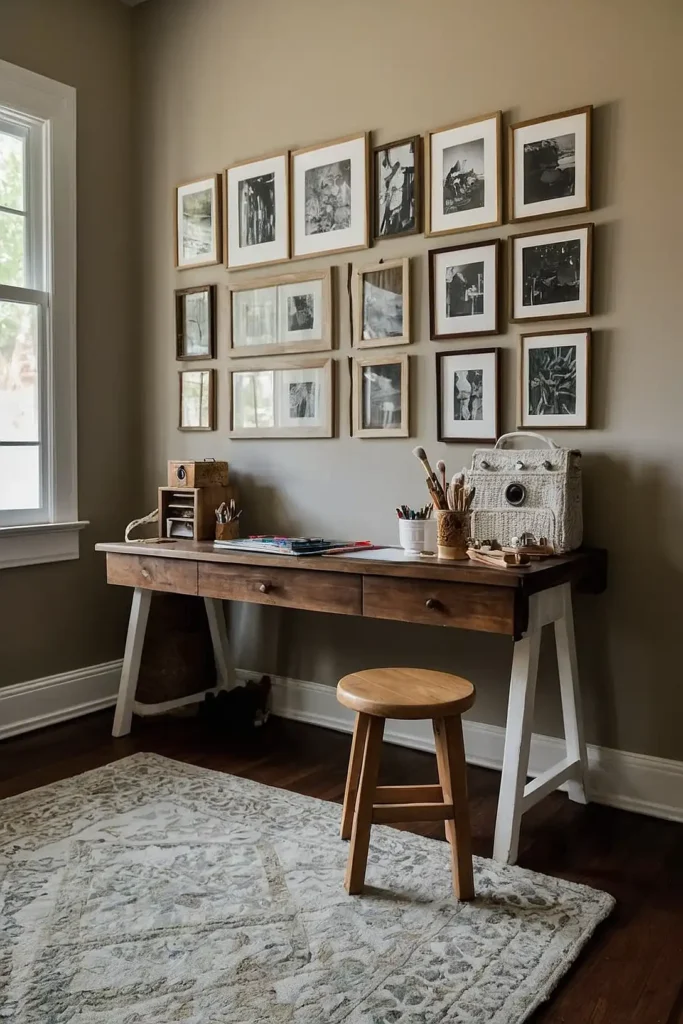
Designate areas for contemplative artistic work where children can focus without social interaction or distraction.
Some children need solitude for their best creative expression. Respect different working styles by providing both social and solitary options.
Children learn about their own needs while developing respect for others’ working preferences.
Include comfortable seating and optimal lighting in quiet zones. The physical environment must support concentration for children who prefer solitary creative work.
20: Use Natural Lighting When Possible
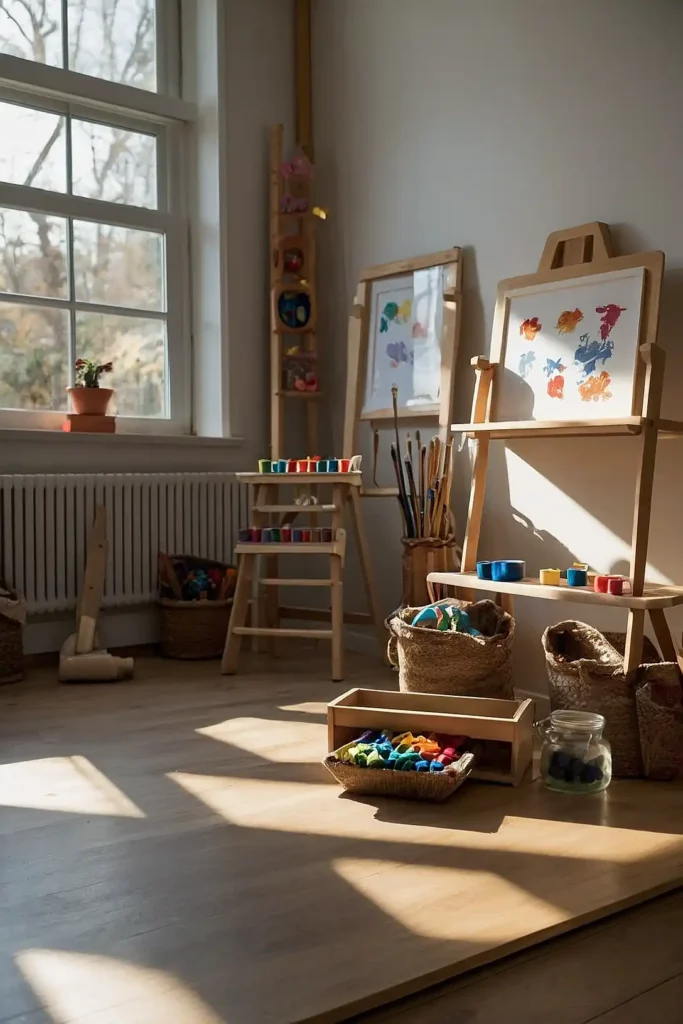
Position work areas near windows to take advantage of natural light for color accuracy and eye comfort.
Quality lighting enhances artistic work while supporting children’s physical well-being.
Supplement with warm artificial lighting when natural light is insufficient.
Children’s artwork improves when they can see colors and details clearly without eye strain.
Adjust workspace positions throughout the day to optimize lighting conditions.
This environmental awareness teaches children to consider practical needs while pursuing artistic goals.
21: Include Cultural Art Examples
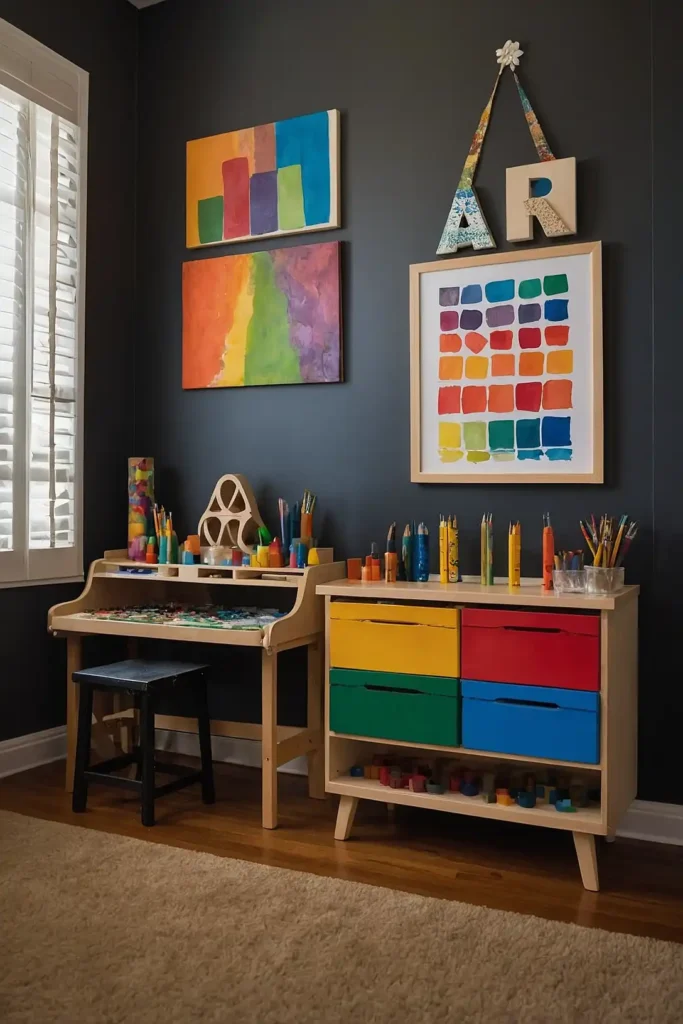
Display artwork from diverse cultures to broaden children’s aesthetic awareness and appreciation for different artistic traditions and expressions throughout human history.
Discuss cultural contexts and techniques represented in displayed artwork.
This cultural education enhances artistic understanding while developing global awareness and respect.
Invite community artists to share their cultural traditions through hands-on workshops.
These authentic experiences connect children to living artistic traditions while building community relationships.
22: Provide Collaboration Opportunities
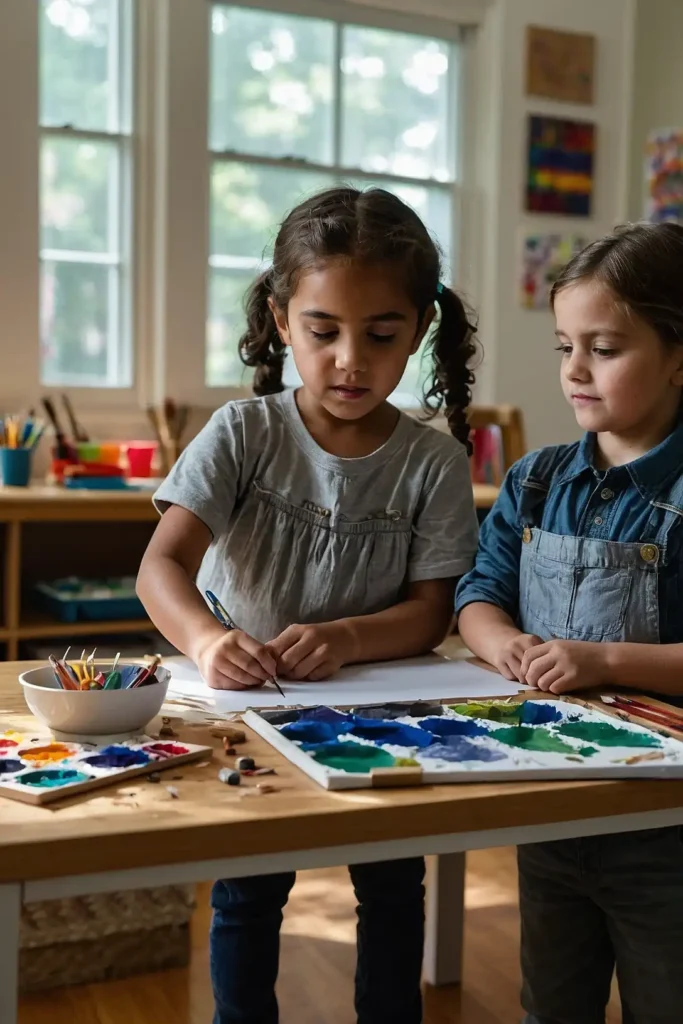
Create projects that require multiple children working together toward shared artistic goals.
These experiences build communication skills while teaching cooperation through creative expression.
Include both planned collaborative projects and spontaneous partnership opportunities.
Children need structure and freedom to develop various social skills through artistic work.
Teach conflict resolution strategies specific to artistic collaboration.
These life skills enhance both social development and creative problem-solving abilities through practical application.
23: Store Work in Progress Safely
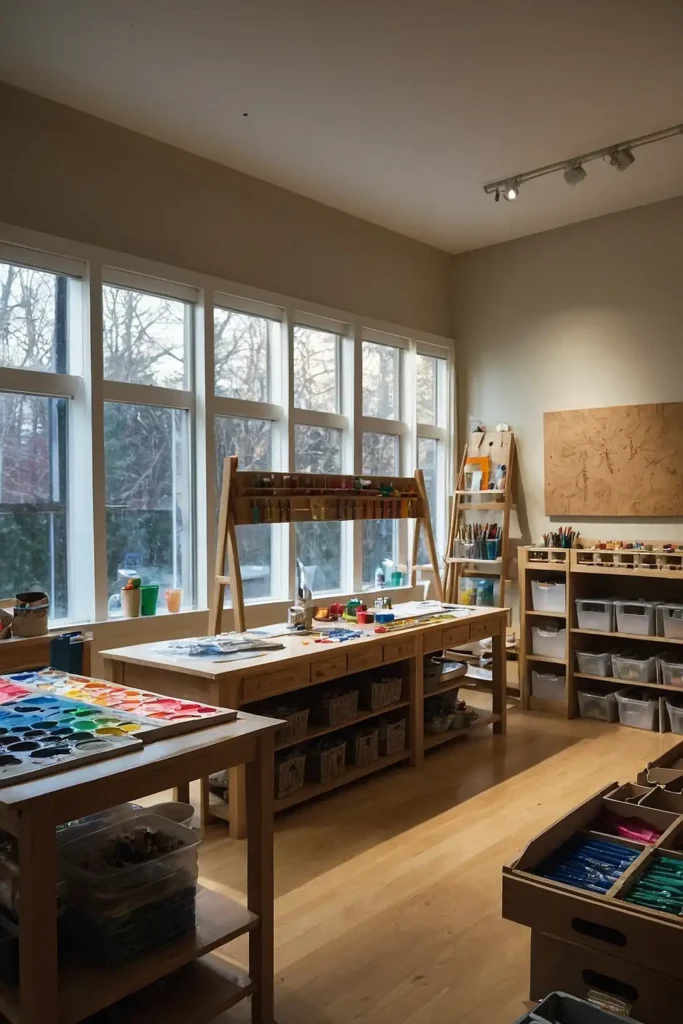
Provide designated spaces where children can save unfinished artwork for future sessions.
This respect for their creative process teaches planning while honoring ongoing artistic development.
Include proper labeling systems so children can identify their own work easily.
This organization skill supports independence while maintaining order in the studio environment.
Teach children to evaluate when artwork is complete versus when it needs additional work.
This self-reflection develops artistic judgment while building decision-making confidence.
24: Use Documentation to Support Learning
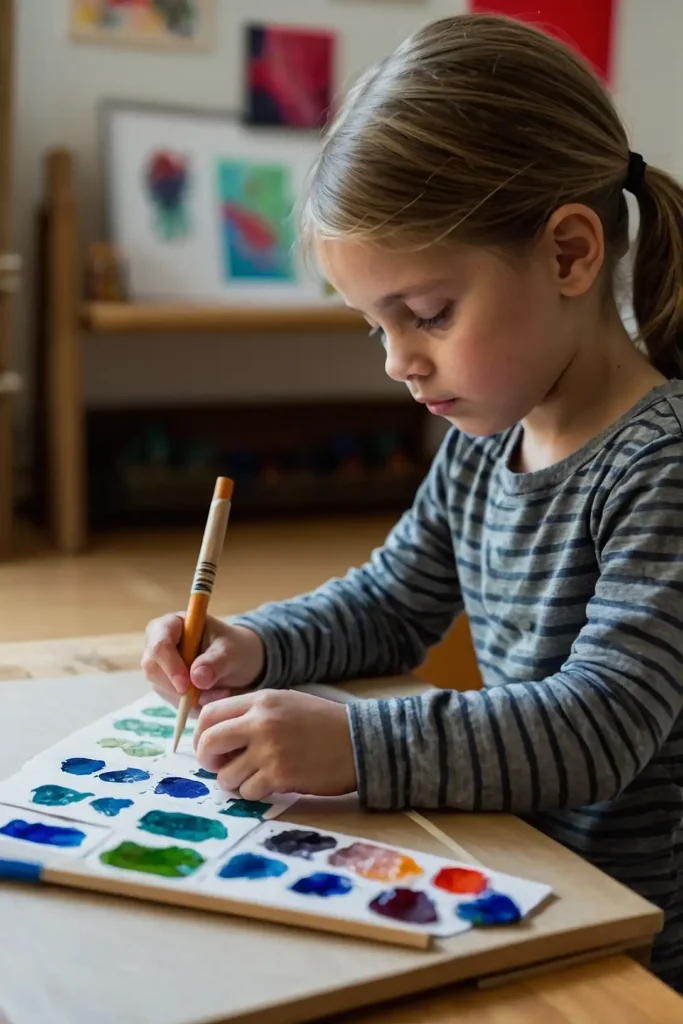
Photograph children’s artistic processes to help them reflect on their techniques and growth over time.
This documentation supports metacognition while celebrating artistic development.
This visual record builds confidence while helping children set goals for continued growth.
Share documentation with families to extend artistic appreciation beyond the studio environment.
Create individual portfolios that children can review to see their progression. This connection builds support for children’s creative development at home.
25: Include Cleanup as Part of the Process
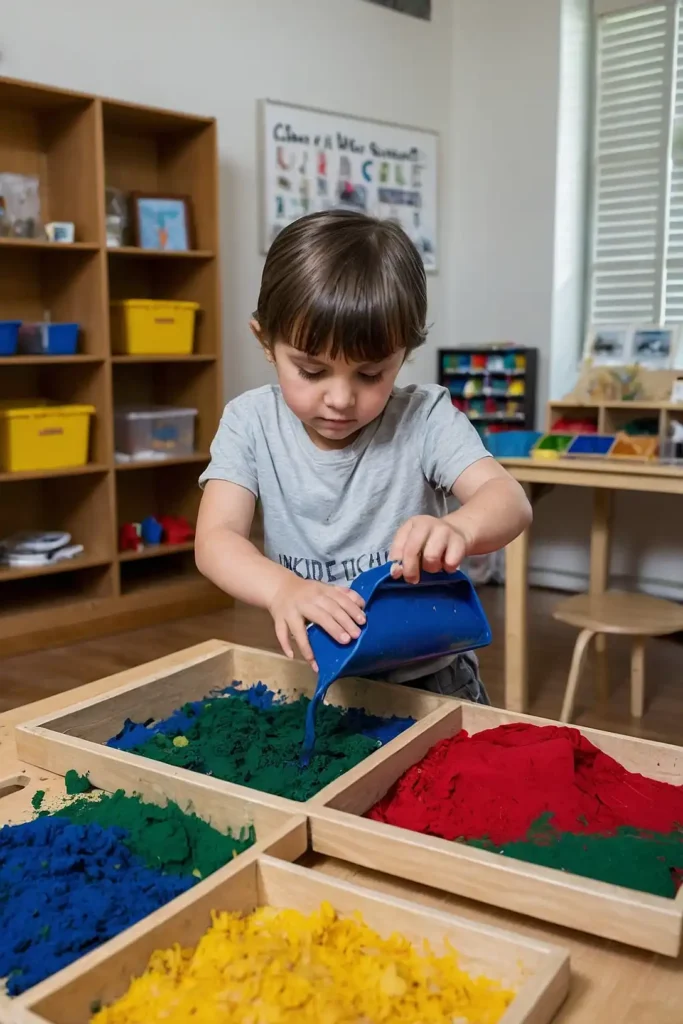
Teach children that cleanup is an integral part of artistic work rather than an unwelcome interruption.
This responsibility builds character while maintaining the prepared environment. Children develop practical skills while taking ownership of their workspace.
Provide appropriate cleaning tools and clear procedures for different types of artistic messes.
Model joy and satisfaction in maintaining beautiful environments.
Children adopt attitudes they observe, making cleanup a positive rather than burdensome experience.
26: Respect Individual Artistic Rhythms
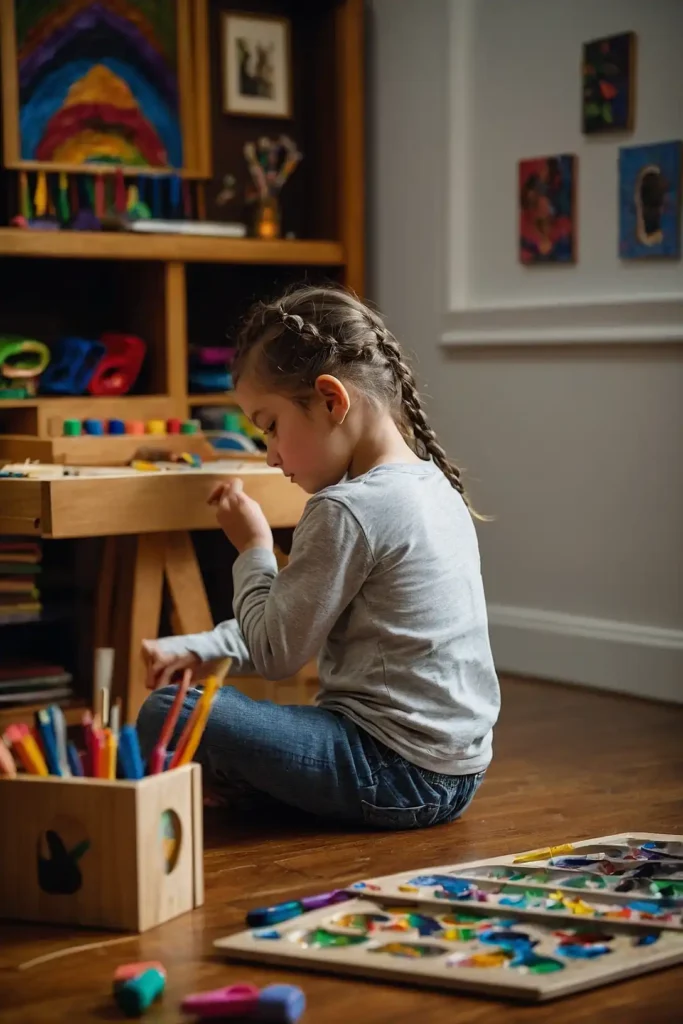
Observe each child’s natural creative patterns and honor their individual pacing for artistic work.
Some children work quickly while others need extended time for meaningful creation.
Avoid rushing children who work slowly or restricting children who work quickly. This individual respect supports authentic artistic expression while building self-awareness.
Document different working styles to better understand and support each child’s artistic development.
This observation-based approach ensures appropriate support for diverse learners.
27: Focus on Intrinsic Motivation
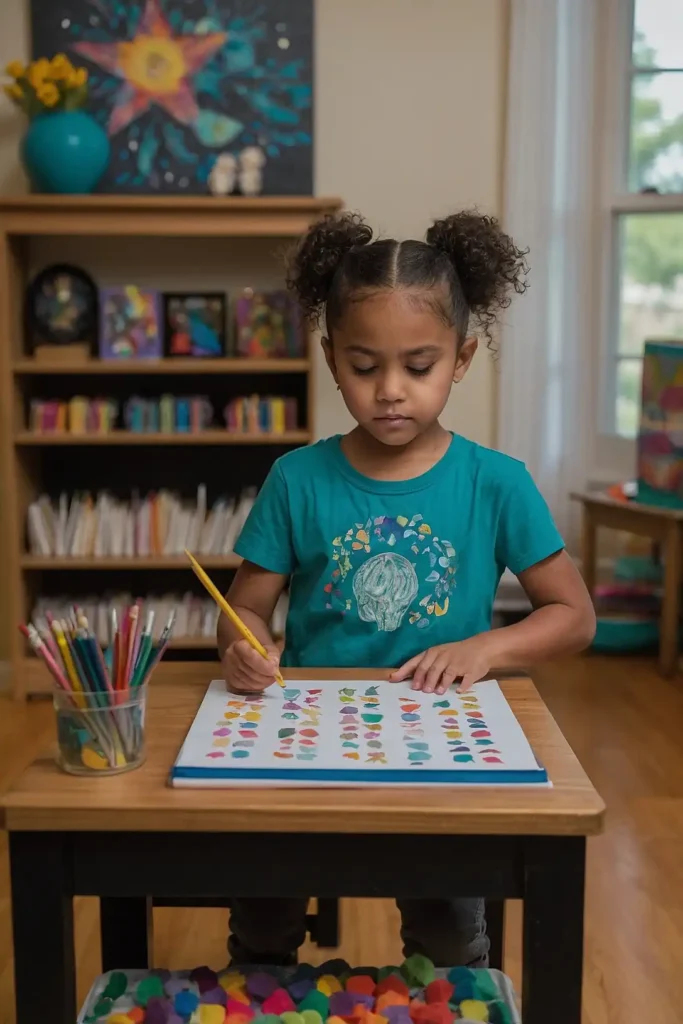
Avoid external rewards or competitions that shift focus from internal satisfaction to external validation.
True artistic development comes from inner drive rather than outside pressure.
Celebrate effort, exploration, and joy rather than only finished products or technical perfection.
This approach builds confidence while maintaining children’s natural love of creation.
Trust children’s innate artistic abilities while providing appropriate support and materials.
This balance of freedom and structure allows authentic artistic expression to flourish naturally.
Conclusion
Your Montessori art studio becomes a sanctuary where children discover their creative potential through beauty, order, and respect for their natural artistic abilities.

